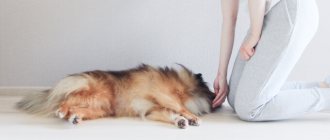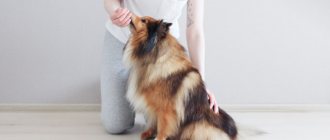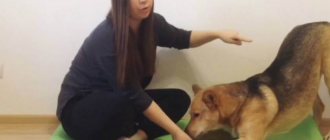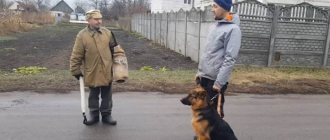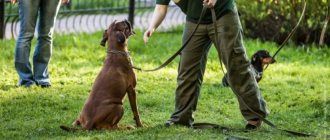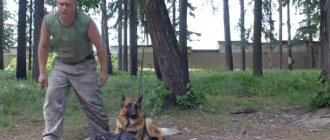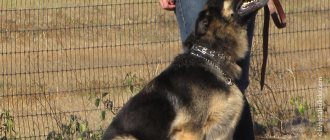Retrieving is a rather complex skill, but most dogs develop it relatively easily and are traditionally included in the general training course (GTC).
What does the “Aport” command mean? On the “Fetch” command, the dog must pick up the thing thrown by the trainer, return to him , go around to the right and behind, and then sit at the left leg, waiting for the trainer to pick up the thing. The dog must not take off and fly towards the thrown thing until the trainer gives the command, and it should not throw the thing until the trainer himself bends down and picks it up.
The “Fetch” exercise differs from the usual game of fetch in that in this case the dog performs all actions only on command.
You can start teaching a command when the dog is 7-8 months old and knows the commands “Come to me”, “Next to me”, “Sit”. So, let's look at how to teach a dog the “Fetch” command.
Why is the "aport" command needed?
The “fetch” command is one of the mandatory ones when passing the OKD (general training course), but it is also used during walks for entertainment purposes.
Spending time with your pet is more fun with a toy - almost any dog loves to run after some object and bring it to the owner.
In addition, all animals need exercise, and the fetch command is a great way to burn off energy.
Why is the skill useful?
So that from the first days the puppy understands who is the boss in the house and does not begin to dominate the person by dictating his own rules, it is important to immediately begin training the pet.
Experts believe that teaching a dog to fetch things thrown into the distance is possible without the help of an experienced dog handler. Not everyone knows what the word “fetch” is for a dog. This is a skill that encourages the animal to run, pick up from the ground, return, walk around the owner on the right and sit on the left. Training is carried out with a puppy aged 7–8 months, who already knows and follows basic commands: “Come to me!”, “Near!” and “Sit!” The benefits of mastering the skill of bringing and giving an object to the owner are obvious: the dog gets used to looking for something and navigating in space, is involved in an interesting game process, using the organs of vision, hearing, smell and all types of its memory.
A conditioned reflex is also developed - the pet learns to build logical chains. Your pet must not only bring back what was thrown, but also learn to control his emotions and be patient, since the prey will have to be given back after the chase and search.
This skill will also allow a pet, whose owner, due to a busy work schedule, cannot walk with him for a long time, get the necessary physical activity.
Choosing a retrieval item
To pass the general training course, a specialized retrieval item is required - a dumbbell.
If you are planning to teach your dog the “fetch” command not for the purpose of passing sports standards, you can choose almost any object - as a rule, it is a dog toy.
The toy should not be too light so that you can throw it to the desired distance without any problems.
Choose an item based on the size of the dog. Do not take a toy that is too large or small, because it will be uncomfortable for your pet and subsequently unpleasant to work with such an item.
Pet stores offer a wide range of toys: ropes, balls on ropes, grips, rings, rubber bones and others.
It is important to consider your pet's taste preferences.
Does your dog like hard toys? Or does your pet have a strong grip and soft, fragile objects are not suitable for him? Does your pet prefer balls or ropes? Maybe your dog will be more attracted to squeaky toys?
Based on the animal’s preferences, choose the most convenient and desirable toy for the dog - this is very important in building motivation, especially in the early stages of training.
It is not recommended to use sticks found on the street, as the animal may pick up a splinter in its mouth.
As a last resort, you can use a stick if you inspect it carefully. The stick should be hard and not falling apart, without any protruding shoots.
Tracking
At the very beginning, the stick is thrown just a couple of meters from the bottom up. It is not recommended to throw over long distances until the dog has established a logical connection with the object.
If at first the pet walks around the stick, the trainer should lead him on a leash and point to it.
After the dog picks up the object, it should be praised and treated with a treat.
Choosing a place to study
The first stage of training, when you just teach the dog the “take” command, can take place at home. The pet does not need to run anywhere, and training will take place in a quiet home environment, when the dog will not be distracted by anything.
In the future, when the pet has to learn to run after a toy, it is better to carry out training on the street, since doing this at home, especially on a sliding parquet floor, will be inconvenient and unsafe for the pet.
Choose a place where people or dogs will not pass by so that your pet will not be distracted or disturb others.
The place should be an open space so that the pet does not run into anything or touch anything during training and execution of the command.
Do not train on wet grass after rain, as the animal may slip and get injured.
Also, you should not exercise on asphalt surfaces; such a coating does not absorb shock, which is harmful to your pet’s joints when he runs on it.
Training technique
Every novice trainer, before starting to train a dog, must understand that the pet should be trained in stages. Each stage involves explanation, bringing the action to automatism, and daily repetition in order to consolidate the acquired knowledge.
Before starting training, you should study the following conditions, which will contribute to the speedy achievement of results.
- Learning a new command from scratch requires special conditions. In the area where the training is carried out, there should be no distractions that affect the innate instincts, and there should be no other dogs nearby.
- Your four-legged friend must be motivated: after each successfully completed command, you need to praise him, pet him and give him a little treat. This technique will allow you to form an emotional connection between the trainer and the dog. The dog will be interested in accurately following all commands in order to get treats.
- While training a pet, a person constantly interacts with it. The owner must clearly understand the stages and results of training in order to explain them to the dog.
- Before training, clarify the boundaries of skill development. The owner must know what exactly should be rewarded with a treat, and the pet must understand what actions are required of him.
At this stage, experienced dog breeders recommend punishing the dog for incorrect execution of one or another command. Pulling the leash and threatening intonation are allowed. As soon as the dog corrects his mistake, you must praise him and give him some cookies.
- First teach your four-legged friend the following commands: “Sit!”, “Come to me!”, “Give!”
- The pet must know canceling commands (for example, “Walk!”). Without them, the dog should not stop the action being performed.
Algorithm for training a puppy and an adult dog
Teaching your pet the “take” command
Take a toy and play a prank on the dog. Play tug of war, drag the toy along the floor. Stop the game at the most interesting moment, when the pet is in the midst of a hobby.
Wait a second and encourage your dog to grab the toy again. If your pet doesn't take the item, start playing it again.
As soon as the dog takes the toy, after a few seconds ask the animal to let it go. Repeat this several times, alternating with a long game so that the dog does not get bored with the learning process.
Enter the voice command “take.” Gradually increase the time you hold the toy.
Advice : if the animal does not want to play, remove all dog toys from free access, forcing the dog to play exclusively with you, and not with himself. Do not play with your pet after a long walk when the animal is tired.
Offer your dog a toy when he is full of strength and energy. To prank your dog, you can tie a toy to a leash and start dragging it away from your pet, and also run away from the animal with the toy. As soon as the dog grabs the “prey”, rejoice greatly at his victory and continue to play energetically with your pet.
It is important to let the dog win, but not to give in too much yourself. Who is interested in fighting with an opponent who is always winning or, conversely, losing?
Don’t let your animal get exhausted during the game; end at the most interesting moment, when your pet is eager to play more.
Offer your dog play at home, and later on outside in quiet, calm places.
Gradually, you can play with the animal in more busy places, teaching the dog to play with you regardless of the situation.
Teaching your pet to pick up something from the ground
After the dog has learned the command “take”, you can safely move on to the next stage - learning to pick up things from the ground.
This skill is learned quickly and effortlessly. First, let your pet remember the “take” command by repeating it several times.
Next, place the toy (the same one that was used in the previous skill) on the ground and command “take it.”
If your pet doesn't understand the task, help him with gestures and pointing. You can throw the toy away a little, encouraging your pet's instinct to catch up and grab the object.
As soon as the dog takes the toy from the ground, say the command “give it back.” Repeat this several times until your pet masters the skill.
Advice: if the dog doesn’t want to give you the toy and starts to get greedy, start running away from the dog in the opposite direction.
Do not run after your pet in an attempt to take away an object - this will irritate the animal even more.
You can also offer your dog a mutually beneficial exchange: she gives you an object, and you give her a treat or another toy that is valuable to her.
Always negotiate with your dog and look for compromises. Do not try to take the item by force, otherwise the animal’s motivation will decrease and it will be unpleasant for him to cooperate with you.
Teaching a dog to carry a thing
Repeat the “grab” exercise with the object on the ground several times. Next, throw the object a little further away from the dog, also commanding “take.” If the dog successfully brings you the object, increase the distance of throwing the toy.
You can enter the “fetch” command at this stage, but you can also leave the “take” command - the dog does not understand human language and it does not matter to her what name you give the command.
As an addition, ask your pet to follow the "sit" command and, while holding it, discard the object. The dog should not explode without your command. If the dog sits quietly, command “fetch.”
Advice : if the pet willingly runs after the toy, but is in no hurry to bring it back, then after the dog grabs the object, run away from it in the opposite direction.
This will encourage the animal to catch up with you, and in this case the dog will speed up. Don't stand in one place if your dog has this problem.
Join the game yourself and show your pet how cool it is to play with the owner and bring him a toy.
Teaching a dog to retain an edible “fetch”
Repeat the “fetch” exercise with a toy. You can add variety and throw other various objects to your pet so that he understands that the owner can bring not only toys, but also other things.
Next, take a large piece of food that the dog doesn't really like. First, the piece should be large enough to make it more comfortable and easier for the dog to understand the task.
For example, you can take a piece of bread. Place the piece on the ground next to you and give your pet the “take it” command. If the dog successfully took and gave you a piece, praise him with some kind of treat, after which you can start throwing food over a longer distance with the “fetch” command.
Gradually, move on to types of food that are more tasty for your pet. It is important to let the dog know that if he holds a treat in his mouth and does not eat it, this will be followed by praise with an even more delicious treat.
Teaching a dog to pick up something from the ground
To teach your dog to pick up something from the ground and present it, do the following: put your dog on a leash and tell him to sit. Then show her the thing and throw it forward a short distance and so that the object is in the dog’s line of sight (you need to throw it at arm’s length from the bottom up). Simultaneously with the throw, say “Fetch!”, point your hand at the object and, together with the dog on a leash, head towards it. When you approach the object, repeat the command again. If the dog does not understand what to do, move the thing with your foot and repeat the command . When the dog takes the object, praise it, walk a couple of steps “next to” with it, then grab the object and say “Give . Praise and give a treat.
Passive inflection method
This method involves physically influencing the animal in an attempt to help it learn a command.
The trainer mechanically sets the pet to the correct position, and then reinforces it by praising the dog with a treat.
In the “fetch” command, using this method, the owner opens the dog’s mouth and puts an object in there, holding it so that the animal does not spit out the thing if necessary, after which he praises the pet with a treat.
Yes, your pet can be taught the “fetch” command using this method. But is it worth it?
Firstly, not all dogs calmly allow a person to get into their personal space, and even in such an impudent manner.
In addition, almost any animal will be unpleasant when its mouth is forcibly opened and an object is shoved into it, and even not allowed to spit it out.
Secondly, when the dog is physically manipulated, his attention will be drawn to the trainer and his actions towards him, and not to teaching the command.
Thirdly, training will not give any mental development to the dog, since the trainer deprives the pet of the opportunity to think for himself, because the owner does everything for him. Whether to resort to this method is up to you.
Skill Development
When the animal has learned to take an object on command, it is time to begin further development of the skill - bringing equipment from a distance.
- the dog is tied on a long leash;
- attract the animal's attention with a thing;
- throw it forward;
- shout out a command;
- when the animal grabs the toy, it is called;
- on the command “Give” the item is taken away;
- give out incentives.
A leash is necessary to yank the pet, after saying “Give”, in case it refuses to come back.
In the future, the work, if necessary at all, becomes more and more complicated:
- they are taught to walk around the trainer from behind and sit down near the left leg;
- they practice endurance “sitting” before sending the animal for the object being aported;
- they teach you to serve a variety of things, and not just one;
- training to find an object thrown into dense bushes, simply hidden somewhere.
Basic mistakes
- Training without playing with your pet . In this case, playing with an animal is an encouragement and relieves the brain for him, because the dog cannot think hard about a task for a long time. Without play, the dog will quickly get bored with the training process.
- Working without a leash on the street when the dog runs away and does not obey . If you know that a dog in an outdoor environment may at some point run away or become greedy with a toy in his mouth, tie a long thin leash or rope to his collar. So, if something happens, you can stop the animal from escaping. The dog should not be allowed to run away during training, otherwise the animal will associate the “fetch” command with disobedience behavior.
- Lack of your involvement in the game . If you stand there and don’t react emotionally to your pet’s success, he will simply become bored. Put more energy and emotion into training, and the animal will be much more willing to cooperate with you.
- Taking away a toy after the command “give it back” every time without reward with a treat . If every time after the command “give” you take away a toy from your dog without offering a treat in return, your pet will associate this command with a negative consequence, and the next time he will not give you the item and will begin to be greedy.
Training should always take place on a mutually beneficial relationship with the four-legged dog.
Actionable tips
Teaching a puppy the “Fetch” command is not as difficult as it might seem at first glance. To cope with this task quickly and easily, follow these rules:
- Before you start teaching the “Fetch” command, you need to practice the skills “Give”, “Nearby”, “Sit”, “Come to me” with the animal.
- Do your workouts daily. Repeat each exercise 3-4 times, after which be sure to take short breaks of up to 10 minutes so that your pet does not lose interest in the exercises.
- Practice for at least an hour. Continue practicing the skill even if the animal begins to lose interest in the exercise. Let it understand that the owner’s order must be carried out regardless of whether you want to do it or not.
- Proceed to the next stage of training only when you have fully mastered the previous one. If your pet is not confident in performing any part of the command, devote more time to practicing this skill.
- If, when executing the “Nearby” order, the pet spits a ball or stick out of its mouth, you need to give it an object in its teeth and silently walk next to it. Do this several times, and the dog will begin to correctly obey the “Near” order, even if you don’t say it.
- Use a leash in the first stages of training. Only after the animal has learned to perform fetch well, start training without a leash.
- Give all orders in a calm, firm tone. Don't raise your voice at your dog, even if it does something wrong.
- Make sure that the dog does not get too carried away with the training object. If he starts playing with it, wait 3-5 minutes until the animal calms down, and then hide the object for 2-3 minutes. After this, the pet will be able to continue training at its usual rhythm.
- Do not show the treat to the dog before the start of the lesson. Otherwise, he will not run after a ball or stick, but will simply sit and wait for a treat. It is best to hide the treat in your pocket or bag so that the animal cannot detect it.
- In between performing commands, be sure to play with your pet and praise it. This will keep him interested in training. It is especially important to do this if you are working with an animal of choleric temperament.
- Practice the command with various objects, conduct training in different places. This will allow the dog to carry out a similar order in the future, regardless of the situation.
- If something doesn’t work out for you during the training process, do not show aggression towards the animal under any circumstances. Remember that you cannot hit the dog or raise your voice at it. You need to control your pet's behavior by pulling on the leash or pressing your hand.
If long-term training with a puppy does not produce results, it is better to seek help from a trainer. He will be able to teach the dog this command in a short time.
Sources
- https://vplate.ru/sobaki/komanda-aport/
- https://vmiresobak.com/vospitanie-i-dressirovka-sobak/kak-nauchit-sobaku-komande-aport.html
- https://gafki.ru/sobaki/aport-komanda-chto-znachit.html
- https://PetGuru.ru/dressirovka/kak-nauchit-sobaku-komande-aport
- https://FB.ru/article/266210/aport-komanda-sobake—chto-znachit-kak-obuchit-sobaku-komande-aport-i-drugim
- https://dogworry.ru/dressirovka/kak-nauchit-sobaku-komande-aport-s-nulya.html
- https://yarus-spb.ru/sobaki/kinologiya/komanda-aport.html
- https://dogtricks.ru/osnovnye-komandy/kak-nauchit-sobaku-komande-aport
[collapse]
Briefly about the main thing
- Take a dog toy or other item that your pet will be interested in and play with it.
- Give the dog the toy for a few seconds, then take it back. Alternate these actions with prolonged play. Repeat this several times, then enter the voice command “take it” and increase the time you hold the toy.
- Place the item on the ground and command the dog to “take it.” If the animal has completed the task, gradually throw the object over longer distances. Enter the voice command “fetch”.
- Train the exercise with endurance included. Give the dog the command “sit” and throw the toy, then command “fetch”.
We hope this article was helpful and informative for you and your four-legged ones. If you still have any questions regarding training based on the content of the article, feel free to ask them in the comments. Good luck!
The final stage
When the dog has learned the exercise well, send it to get the object while you stay behind it. When the dog takes the object, say “To me” and then “Nearby”. Wait until the dog sits to your left and take the item. Now praise her and encourage her.
The dog comes, sits and gives the item on command
Gradually cancel the intermediate commands “Come to me”, “Nearby”, the dog must correctly do the entire set of exercises according to one command - “Fetch”.
Best time to practice
It is important that during training the dog is not too full and not too hungry. That is, at least 2 hours must pass after eating. The animal should not be sleepy and tired, otherwise it is unlikely to bring the owner a ball or any other thing. Of course, you should not train a pet that is not feeling well (poor appetite, weakness, digestive disorders, high fever, etc.).
In addition, what the animal’s mood is is of great importance. If your pet is angry, sad or overly excited, it is better to postpone training for a while. By the way, not only the attitude of the dog itself is important, but also that of its owner. You should not start training if your heart is not right. A bad mood will certainly be transmitted from a person to an animal.
A little theory
Training a dog is a long process, the goal of which is to form a conditioned reflex to a specific stimulus. In this case, several will act as this:
- voice command “Aport”;
- gesture (throwing the thrown object with the right hand);
- teasing (swinging things in front of the animal's eyes);
- delicacy;
- encouraging affection.
If training is carried out with an adult dog, then the study of “fetch” begins only after the commands “come to me” and “sit” have been worked out.
